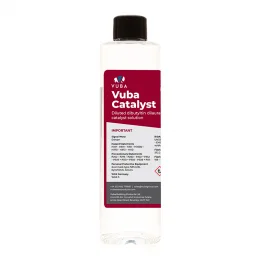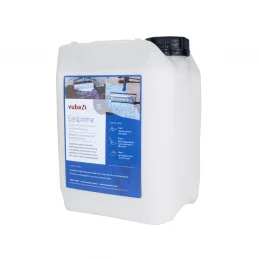- There are no more items in your cart
- Shipping Calculated at checkout
-
Sub-Total (inc. VAT)
£0.00
An aliphatic two component polyurethane stone encapsulation binder, for use on driveways, pathways and other landscaping surfaces.
- For use with Vuba Aggregates and Binding Quartz
- NEW Moisture Tolerant Version is available HERE and included in our NEW AND IMPROVED Resin Bound Kits:
Quick Links - Click To Jump To Section:
- Technical Data
- Resin Ratio
- Colours
- Curing Times
- Suitable Substrates
- Application Guidance
- Cleaning Guidance
- Maintenance Guidance
- Limitations
- How to Apply a Resin Bound Sealer
Technical Data
Analytical Chemistry:
| Vuba Resin Bound Binder | Unit | |
|---|---|---|
| Hydroxyl Value | 162 | mgKOH/g |
| Acid Value | 1,3 | mgKOH/g |
| Viscosity, 23°C | 2650 | cP |
| Colour | 3,1 | G |
Physical Properties:
| Vuba Resin Bound Binder | Unit | |
|---|---|---|
| Hardness | 40 | ShD |
| Tensile strength | 12,3 | MPa |
| Elongation | 67,2 | % |
| Tear resistance | 18,8 | N/mm |
Resin Ratio
It is important the correct ratio of resin to aggregate is used.
Cube strength tests carried out in accordance with BS EN 1290 – 3: 2009 demonstrate that a 6.5kg sized resin bound binder will be 19% weaker than a 7.5kg resin bound binder when used with a standard 106.25kg aggregate mix.
Vuba Resin Bound Binder is 7.5kg in size.
Colours
The surface colour is determined by the aggregate used within the mix. Refer to Vuba Aggregates for more information on available colours.
Curing Times
The curing time is determined by the inclusion of Dibutyltin Dilaurate Catalyst.
Curing times are temperature dependant; for example, pre catalysed resin can take 24-48hrs to cure, with a work time of 30-40 minutes if used at the graded temperature.
Suitable Substrates
See the ‘Vuba Base Build Up’ Datasheet for advice on the correct base and sub-base build up for use with Vuba Resin Bound Binder.
Tarmac
Vuba Resin Bound Surfacing
The thickness required for your resin bound surfacing is dependent upon the usage, and the size of the aggregate in the blend you choose. Please see the following as a general guide:
- Pedestrian Traffic - 12mm to 15mm
- Parallel Driveways - 18mm
- Turning Vehicle / Heavy Traffic 18mm to 21mm
Contact our technical team for advice and specification on your project on 0113 2455450 (option 2) or send a message to [email protected]
Binder Course
Minimum 50mm depth of open grade asphalt 100/150 pen to BS EN 13108-1:2006.
Sub Base
150 – 225mm depth of well compacted non-frost susceptible Type 1 granular sub base.
Sub Grade
Top soil stripped back until organic and vegetative material has been removed.
Advice: Open grade Tarmacadam is the base recommended by Vuba for all new projects which are to receive vehicle traffic. This base has excellent flexural strength, is fully permeable and interlocks excellently with resin bound surfacing.
Concrete
Vuba Resin Bound Surfacing
The thickness required for your resin bound surfacing is dependent upon the usage, and the size of the aggregate in the blend you choose. Please see the following as a general guide:
- Pedestrian Traffic - 12mm to 15mm
- Parallel Driveways - 18mm
- Turning Vehicle / Heavy Traffic 18mm to 21mm
Contact our technical team for advice and specification on your project on 0113 2455450 (option 2) or send a message to [email protected]
Binder Course
Minimum 100mm concrete, finished to a tamped or brushed finish. Compressive strength to be 30N/mm2 and tensile strength 2.5N/mm2. Relative humidity to be below 85% RH in accordance with BS 8205.
Sub Base
150 – 225mm depth of well compacted non-frost susceptible Type 1 granular sub base.
Sub Grade
Top soil stripped back until organic and vegetative material has been removed.
Concrete is susceptible to cracking / joint movement which can reflect through into the in situ applied resin bound surfacing. Care should be taken to ensure joints / cracks are treated or reflected through into the resin surfacing.
Vubagrid Cellular Paving
Vuba Resin Bound Surfacing
The thickness required for your resin bound surfacing is dependent upon the usage, and the size of the aggregate in the blend you choose. Please see the following as a general guide:
- Pedestrian Traffic - 12mm to 15mm
- Parallel Driveways - 18mm
- Turning Vehicle / Heavy Traffic 18mm to 21mm
Contact our technical team for advice and specification on your project on 0113 2455450 (option 2) or send a message to [email protected]
Vubagrid
40mm depth with 25mm spikes fully connected cellular reinforcement structure infi lled with well compacted 4/10mm graded crushed aggregate to BS EN1260.
Sub Base
150 – 225mm depth of well compacted non-frost susceptible Type 1 granular sub base.
Sub Grade
Top soil stripped back until organic and vegetative material has been removed.
Concrete is susceptible to cracking / joint movement which can reflect through into the in situ applied resin bound surfacing. Care should be taken to ensure joints / cracks are treated or reflected through into the resin surfacing.
Application Guidance
Cleaning Guidance
If power washing the surface, use only sufficient water pressure to remove dirt or contamination. Use cold water only (maximum 40℃) with a fan jet, maintaining at least 300 mm between the lance and the surface holding the lance at an angle of approximately 450. Avoid concentration of the jet on one area by using a sweeping action from side to side.
Cleaning products should be pH neutral where possible and biodegradability should be considered when cleaning permeable pavement as chemicals will drain to natural water courses. When using acidic or alkaline cleaners, pH should be as close to neutral as possible and cleaners should be neutralised before flushing with clean water to reduce the risk of staining and degradation of the resin. A discrete test patch should be chosen for a trial before general use.
Maintenance Guidance
Regular appropriate cleaning of surfacing materials will contribute to the durability of the surfacing. As with any surfacing material, resin bound surfacing should be cleaned regularly and as frequently as necessary to maintain its appearance. Sweep with a broom to remove leaves, paper etc. Use water as necessary to wash the surface and only use cleaning products when water and a sweeping brush are insufficient for cleaning the surface. The use of abrasive pads and wire brushes should be avoided.
Removing Moss, Algae and Lichen - After brushing off biological growth, remove remaining moss, algae, lichen or other biological growth from the surface with a proprietary fungicide. Flushing with clean water may not be necessary and may affect the long term effectiveness of the treatment. Follow the instructions of the manufacturer and abide by local regulations with regard to the use of chemicals. Periodic use of a fungicide should be considered as a preventative measure in areas where conditions are likely to promote biological growth.
Limitations
Shaling - The surfacing may be affected by the shaling action of tyres when vehicles are turning in confined spaces. Tyres must not be turned when in a slow turning or static position. Wheels should not be regularly turned in confined spaces. Debris and loose stones must not be trafficked on to the resin bound surface, as this may result in de-lamination of the screed.
Regular inspections should be carried out to ensure early detection of damage should this occur.
Cracking – Resin bound surfacing is typically applied as a seamless finish, and as a result could suffer from cracking over time. There are various types of cracking: Reflective Cracking (Cracking as a result of movement or cracking in the base which is reflected in the resin bound surface); Re- Entrant Cracking and Subsidence Cracking. See ‘Vuba Resin Bound Warranty’ document for more information.
How to Apply a Resin Bound Sealer
This guide shows you how to make a sealer for resin surfacing using our Resin Bound Binders.
A Resin Bound Sealer can be applied to both old and new resin bound surfacing for the following reasons:
- Improve surface strength
- Rejuvenate and colour enhance
- Help to bring uniformity
The Resin Bound Sealer is solvent based, high strength and modified for easy roller coat application on to resin surfaces. The Resin Bound Sealer is simple to make and applied to the surface using a brush and a roller.
Materials Needed
- 7.5kg Vuba Resin Bound binder
- 1.5ltr white spirit
- Scuttle bucket
- Medium pile roller
- Paint brush
- Accelerex (if required)
- Crushed glass (if required)
Preparation
Ensure the surface is clean, dry and free from contamination. The surface must be dry or the Resin Bound Sealer will react with excess moisture and blooming will occur. This will look like pale foaming on the surface, and will leave an unsightly finish. Mark out the area required to apply first, to ensure even distribution.
Mixing
STEP 1
Addition Quantities of White Spirit:
- 350ml addition to a 1.75kg Resin Binder
- 1400ml addition to a 7kg Resin Binder
- 1500ml addition to a 7.5kg Resin Binder
White spirit must be added to the Part A and mixed until fully blended.
STEP 2
At this stage it is recommended to add Accelerex, a catalyst to increase the speed of curing. This is again added to the Part A and mixed in.
White spirit retards the curing process and so a dose of 4ml of Accelerex is recommended, with the option to include higher doses.
STEP 3
Pour the ‘Activator B’ into the larger ‘Resin A Tub’ and mix both components for 90 seconds.
STEP 4
Pour the mixed Resin Bound Sealer into a scuttle ready for application.
STEP 5
Apply using a medium pile roller, ensuring not to allow pooling. The resin will sit on the surface and begin to seep into the cavities after 15-20 mins. Oversaturation may remove the permeability of the system.
STEP 6
Scatter crushed glass on the top surface – this will add anti-slip to the surface. (OPTIONAL)
STEP 7
Apply a second coating for weak surfaces, which require additional strengthening.
STEP 8
Allow to cure for 48-72 hours depending upon temperature.
Data sheet
- Single, Two or Three Pack
- Two-Pack
- Pack Size
- 7.5KG
- Suitable For Use On
- Stone
- Components
- 2K
- Product Usage Type
- Binder
- Colour Family
- Yellow
- Colour Family
- Clear
Questions
Question about the product
Be the first to ask a question about this product!
IMPORTANT SHIPPING & DELIVERY INFORMATION
Vuba Trade Resin Bound Binder is only available with the shipping and delivery timescales listed below - please do not contact our Customer Support Team with enquiries about alternative or earlier shipping and delivery times.
Saturdays and Sundays, as well as Bank Holidays, are not classed as working days.
Orders placed after the cut-off for this product will not be processed for earliest dispatch until 9am the next working day.
All delivery costs below are excluding VAT

Vuba Application Tools & Accessories
Tools and equipment for application of the Vuba range of resins, binders, and aggregates. Includes trowels, spazzle, and application sledge Note: Extra shipping charges apply at checkout to Spazzle, and Application Sledge due to size restrictions More Information Delivery Info

Vuba Resin Bound Catalyst
Catalyst, chemically known as Dibutyltin Dilaurate Catalyst, is used to speed up the cross-linking process of two-component polyurethane systems. Catalyst favours the reaction between the resin and the hardener, limiting side reactions such as the hardener and water. In pre-catalysed resin kits, the catalysed component is in the Part A of...

Vuba EasiPrime
An acrylic primer used for sealing concrete prior to the application of Resin Bound Surfacing. Used to seal and remove porosity in concrete substrates, to enable a strong chemical bond between a Resin Bound Screed and the Concrete substrate Can be applied to most cementitious substrates, such as concrete and polymer modified screeds Apply...


